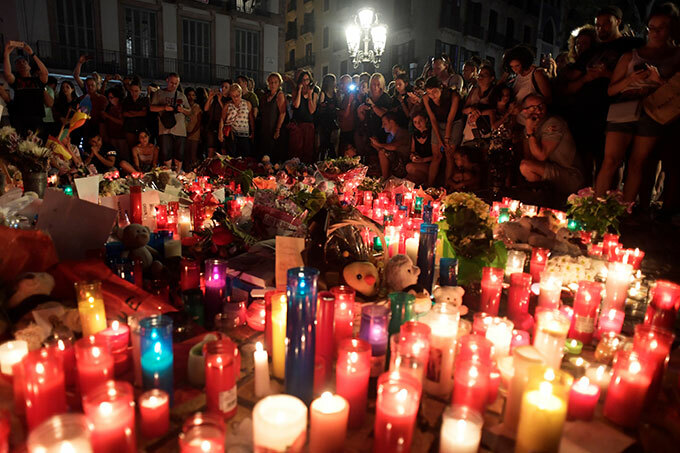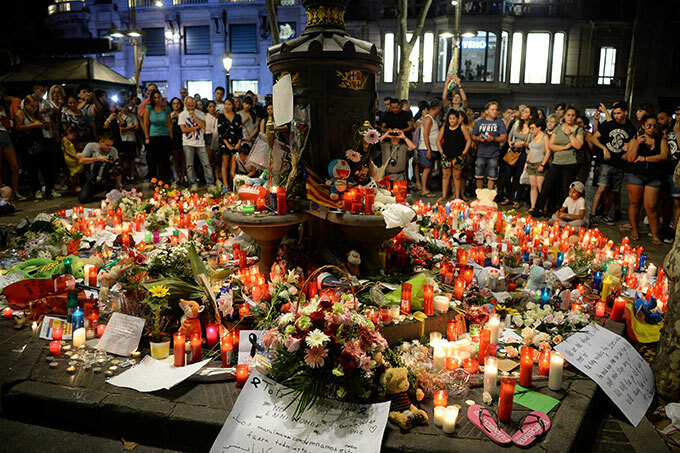Spain twin vehicle attacks: What we know
Aug 19, 2017
Around 4:50 pm (1450 GMT) on Thursday, a vehicle ploughed into a crowd of pedestrians on the famous Las Ramblas boulevard in Barcelona.

At least 14 people were killed and more than 100 others injured after drivers slammed into pedestrians in two quick-succession, separate attacks on Barcelona's most popular street and in another busy Spanish seaside town.
What happened?
Around 4:50 pm (1450 GMT) on Thursday, a vehicle ploughed into a crowd of pedestrians on the famous Las Ramblas boulevard in Barcelona.
The promenade in the heart of the city is one of Barcelona's busiest streets, normally thronged with tourists and street performers until well into the night.
Witnesses described scenes of chaos and panic, with bodies strewn along the boulevard as others fled for their lives.
 People stand next to flowers, candles and other items set up on the Las Ramblas boulevard in Barcelona as they pay tribute to the victims of the Barcelona attack, a day after a van ploughed into the crowd, killing 14 persons and injuring over 100 on August 18, 2017 / AFP Photo / Javier Soriano
People stand next to flowers, candles and other items set up on the Las Ramblas boulevard in Barcelona as they pay tribute to the victims of the Barcelona attack, a day after a van ploughed into the crowd, killing 14 persons and injuring over 100 on August 18, 2017 / AFP Photo / Javier Soriano
The driver fled on foot. Police have since said he may be among several suspects killed in the hours since the mayhem started.
Second attack
Some eight hours after the Barcelona attack, an Audi A3 car hit pedestrians in the resort town of Cambrils, 120 kilometres (75 miles) to the south. Six civilians and a police officer were injured; one of the civilians, a woman, later died.
The five occupants of the car were killed by police.
When asked if the Barcelona driver may have been among those killed, Josep Lluis Trapero of Catalonia's police said "the investigation points in that direction," while cautioning that there was no "concrete proof".
Who are the victims?
Emergency services said at least 14 people had died and around 100 more were injured in the two attacks.
There were some three dozen nationalities among the dead and injured who came from countries as varied as France, Pakistan, Spain, the Netherlands, China, Venezuela, Mauritania, Australia, Britain and the United States.
At least one American was killed in the attacks, US Secretary of State Rex Tillerson said.
Rome said two Italian nationals were killed including a man who died in front of his wife and young children, and Belgium said one of its citizens was among the fatalities.
A 74-year-old Portuguese woman was also among the dead, the government said, while a man called Tony Cadman launched a Facebook appeal for his seven-year-old grandson who is missing.
Prime Minister Justin Trudeau said one Canadian was killed while Argentina's foreign ministry said a 40-year-old woman, Silvina Alejandra Pereyra, who had dual Spanish-Argentinian citizenship, was among the dead.
So far France appears to have the most citizens among the injured, reporting 28 wounded with eight gravely hurt.
Who is behind it?
The Islamic State's propaganda agency Amaq claimed that "soldiers" from the jihadist group carried out the Barcelona attack, according to the SITE Intelligence Group which monitors Islamist websites.
"The executors of the Barcelona attack were soldiers of the Islamic State," Amaq said, quoted by SITE.
Catalonia's regional police identified three of the suspects who were killed as Moroccan nationals.
They were Moussa Oukabir, 17, Said Aallaa, 18, and Mohamed Hychami, 24.
Police said they suspect 12 people of involvement in the attacks: the five who were killed in Cambrils, four who were arrested and three who have been identified but whose whereabouts have not been confirmed.
Officials suspect that two of these three may have died in a blast at a house in the town of Alcanar, about 200 kilometres (140 miles) south of Barcelona, on Wednesday evening.

Initially treated as a random gas blast, police later linked it to the Barcelona assault, believing occupants of the house were preparing an explosive device inside.
The explosion in Alcanar destroyed "the material they needed to commit attacks of an even bigger scope", Catalonia police said.
Previous attacks in Spain
Spain was hit by what is still Europe's deadliest jihadist attack in March 2004, when bombs exploded on commuter trains in Madrid, killing 191 people in an attack claimed by Al Qaeda-inspired extremists.
In July 2015, a hooded attacker opened fire outside a hotel in downtown Barcelona near Las Ramblas boulevard, leaving two people injured, police said.
No suspected motive for that attack was given.
